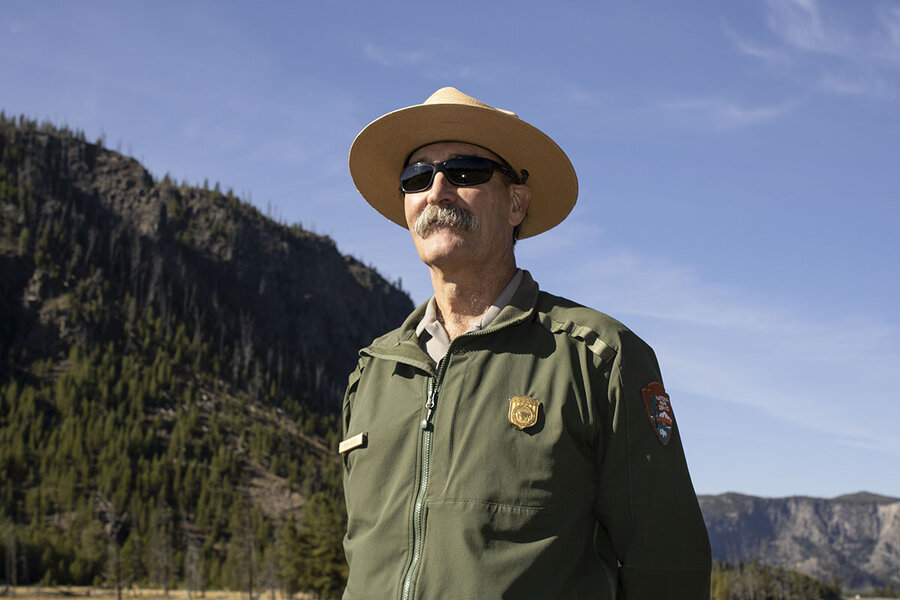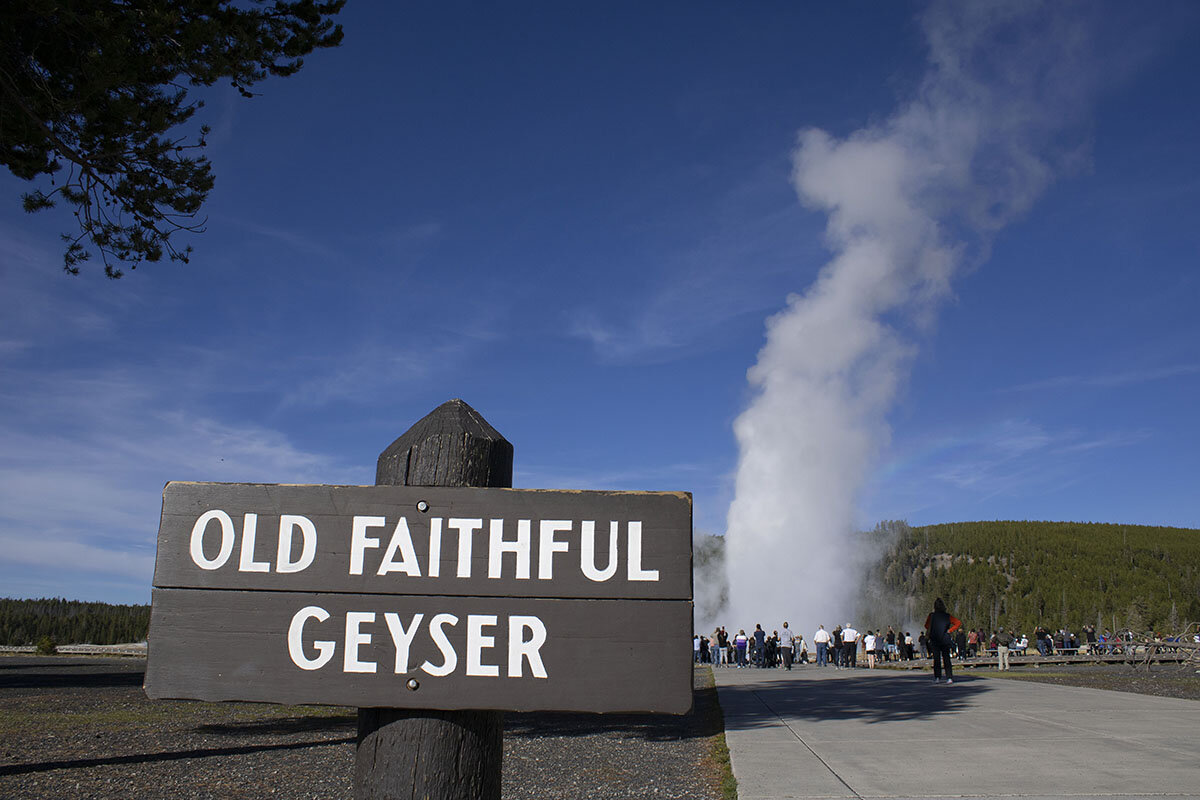Yellowstone at 150: ‘It’s never dull’
Loading...
| Yellowstone National Park, Wyo.
Yellowstone National Park is celebrating its 150th anniversary this year. But the park extends beyond 1872, of course; several Native American tribes hold older ties to the land.
Beyond the brim of his ranger hat, Rich Jehle sees future chapters, too. The West District interpretive ranger, who has worked here for over three decades, spoke with the Monitor about his work one October morning.
Why We Wrote This
A story focused onAfter 150 years, Yellowstone National Park continues to inspire. A park ranger reflects on the responsibility of long-term stewardship.
“I think the favorite moments a lot of times are the simplest ones,” he says. “It’s when you get that ‘aha’ moment from a visitor” – about showing respect for bears or bison, for example.
Speaking of which, a black bear knocked on his front door once and later showed up on his back porch. “We kept the trap out there for at least a week, and the bear never got in the trap. It was very smart,” Mr. Jehle says.
Asked how his work has transformed his life, Mr. Jehle says he feels lucky to have spent his career in such a “spectacular” spot, but “this place doesn’t belong to me,” he adds. “It belongs to the future, to my kids, and their kids, and the rest of the American public, and the rest of the world.”
Graceful geysers, grizzly bears – there’s no shortage of adventure in Yellowstone National Park, which turned 150 this year.
The story of this first U.S. national park, which spans 2.2 million acres (in three states), extends beyond 1872, of course; several Native American tribes hold older ties to the land. Beyond the brim of his ranger hat, Rich Jehle sees future chapters, too.
Yellowstone belongs “to my kids, and their kids,” Mr. Jehle tells the Monitor one October morning in the park, rocky ridges reflected in his L.L. Bean shades. A bison lumbers in the distance.
Why We Wrote This
A story focused onAfter 150 years, Yellowstone National Park continues to inspire. A park ranger reflects on the responsibility of long-term stewardship.
The West District interpretive ranger has worked here for over three decades. Yellowstone is also where the mustachioed naturalist met and married his wife and where they raised two daughters. In an outdoor interview near Madison Junction at the base of National Park Mountain, he discussed the responsibility of long-term stewardship and a lesson in renewal from the fires of 1988.
Our conversation has been lightly edited and condensed.
What does a typical day look like for you – if there is such a thing as typical?
The thing I like about my job is it’s never dull. My duties have changed a lot over the years. When I first started working here, I was doing a lot of the front line, interacting with visitors a lot, working the park entrance stations. … Over time I got into the division of interpretation. … Right now, I think my main goal is supervising a staff and sort of helping younger folks that are working for me learn about the park, learn about how to share the park’s resources and values with the visitors, and providing the best visitor service we can so people learn to love their national parks – and hopefully get inspired to preserve them and pass them on to the next generation.
What are important attributes for rangers to have?
You need to be flexible. You need to be willing to work hard. There’s sort of this romantic image of what it’s like to be a park ranger, which in a lot of ways is true. But there’s also, just like any other job, there’s a lot of stuff that’s just hard work. It’s hard work to greet millions of visitors coming to Yellowstone and keep a smile on your face, and treat everyone with respect, and like you’ve never heard the question before that you get asked.
For instance, I have staff that work under me, that work at Old Faithful visitor center – one of the most visited spots in the entire national park system and one of the most iconic places in America. Of course, the first question that everybody hears is: “When is Old Faithful going to go off?” … You have to be able to answer that question the same for the 5,000th person that you’ve talked to this week, or the 100,000th person you’ve talked to this year, with the same enthusiasm that you did with the first one.
Have you had a favorite moment with a visitor over your three decades here?
I think the favorite moments a lot of times are the simplest ones. It’s when you get that “aha” moment from a visitor, when you are talking to them about Yellowstone, and maybe it’s how Old Faithful erupts – just something as simple as that. How does it work? It’s not a clock. It’s not something that we schedule. It’s a natural feature that is variable. We are able to predict how it erupts one eruption at a time. … Or when you talk to visitors about: Why are grizzly bears important? Why can’t I go get too close to a bison? When the visitors make that connection that this is a wild animal living in a wild place, and that we need to respect their space in order to be safe and allow them to survive. … The mission of this agency is to preserve Yellowstone, preserve the national parks, “unimpaired” for future generations. That’s the language from the Organic Act, from when the National Park Service was established in 1916. I really take that to heart.
Have you had a favorite moment with a four-legged creature?
In 1988, actually, when I lived right across the street from where we’re sitting right now … I was in my apartment cooking a hamburger, and I heard a knock at the door. … It took me a second for it to click in what I was looking at, but there was a bear leaning against the glass [door]. A black bear, leaning against the glass. I was literally six inches face-to-face with this bear. … I ran over [to a ranger station], got on the phone, called up our dispatcher, and told them what’s going on. It’s like, there’s a bear roaming around the housing area here, and it was just trying to get in my apartment.
At least he was kind enough to knock.
Correct. … We kept the trap out there for at least a week, and the bear never got in the trap. It was very smart. Then we kind of all forgot about it. A few weeks later … I was doing laundry, and I’m walking back to my back door of my apartment in the dark one night. … All of a sudden, I hear this sound, like, woof! And it’s the bear. I’m sure it was the same bear. It was on my back porch. … I managed to back away, slowly, walk all the way around the front, get in my apartment, and just close the door. Never saw the bear again, and it never got trapped. That was one of the most memorable encounters I’ve had with wildlife in the park.
You were witness to the 1988 fire. You’ve also seen the park weather this most recent flooding event over the past year. You’ve seen this park bounce back.
It’s interesting. … I learned pretty early on that it’s all about perspective, as far as when you start talking about the fires of ’88. For many, it was the end of the world as we know it: “Yellowstone’s never going to be the same.” I felt the same way. … Charred stumps and acres, thousands of acres, of just charcoal and black.
The lodgepole pines are an interesting tree in that they depend on fire to regenerate. … They have two different types of cones. They have an annual cone that opens … and spreads seeds. They are supremely adapted to this particular environment – really poor volcanic soils at this elevation in this sort of climate. They grow like weeds. But they also have a second type of cone. Some trees have almost all this type of cone, some trees have none, some have a mix. They’re called serotinous cones … and they will only open when the temperature gets to 113 degrees, which never happens here except when there’s a fire.
Are you saying that the lodgepole pines that we’re looking at here – their growth is due to the fire in ’88?
A lot of them. … One of the things that we are trying to do in the national parks and the guiding management philosophy since the 1960s, since the Leopold Report, … is to allow natural events to play their course as much as possible. Now that was hard in 1988, because it had never been tested on this scale to allow fires to burn. … You can look at fires as a disaster, or you can look in the setting of a national park like this. You can look at the ecology of the park, which tells us that fires are just another part of the natural ecosystem – just like running water, just like wind, just like rain.
Last year was Yellowstone’s busiest on record with nearly 5 million recreation visits. How have you seen the park evolve as it becomes ever more popular?
This year was kind of a weird exception, because after the big flood event back in June, we had two out of the five park entrances … closed [though one reopened this month]. … I suspect we’re going to rebound back up and be very, very busy again. So that has changed: There’s a lot more people in the road corridors now than there were when I first started working here.
How has this job transformed your own life?
I think the way it’s transformed me is that I feel proud about my work. … I can talk to people or help solve problems on a day-to-day basis. … I am very proud to have lived here and raised a family here that also values wide open space, and clean air, and clean water, and the value of public lands.
One thing that I always come back to is this place – I’m a steward of this place. I don’t own Yellowstone. I’m lucky, because I’ve been able to work here and make a career out of someplace so spectacular, and hopefully do more good than harm in the long run. But ultimately, this place doesn’t belong to me. It belongs to the future, to my kids, and their kids, and the rest of the American public, and the rest of the world.









